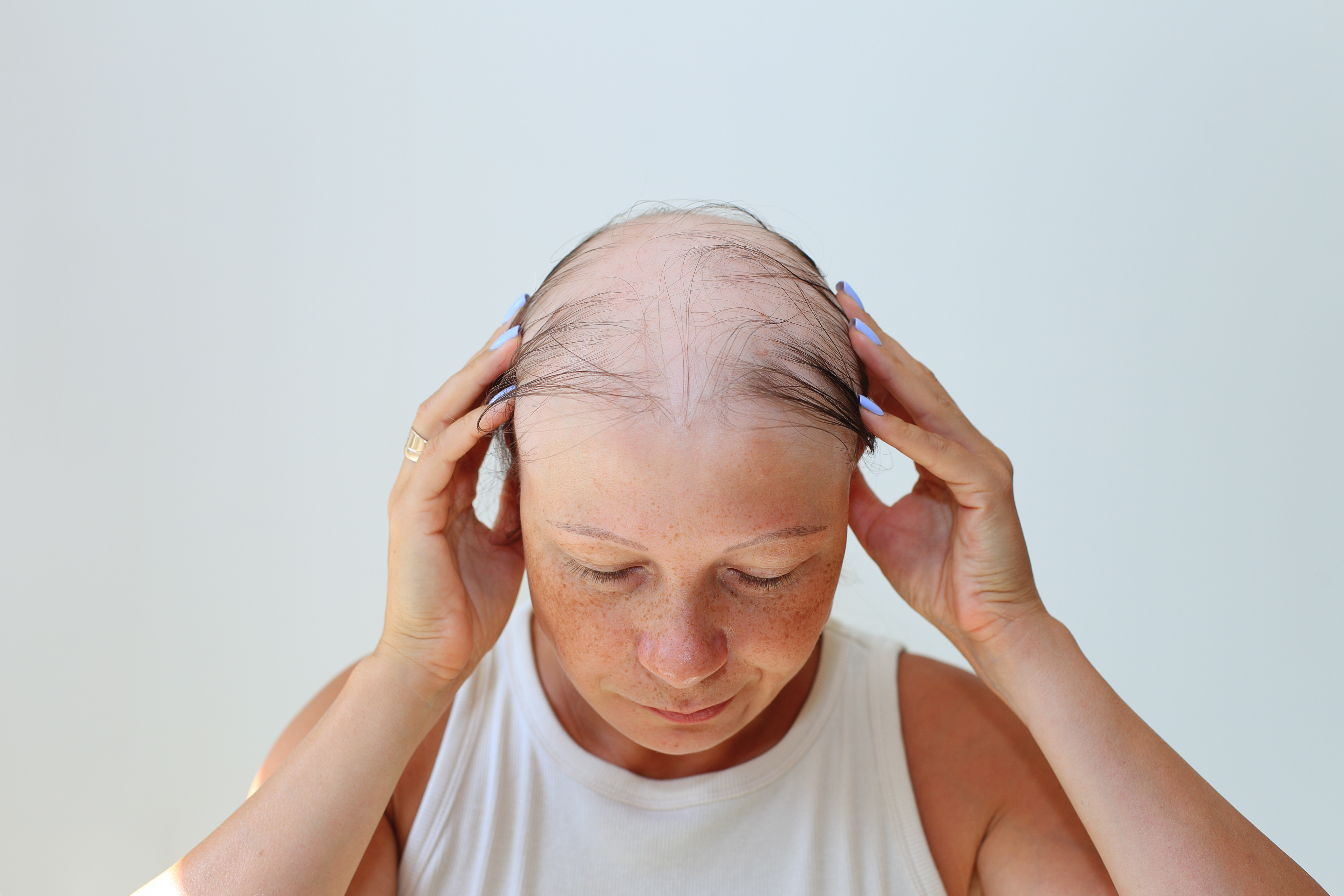Alopecia Areata: A Common Type of Hair Loss
Alopecia areata is a prevalent form of hair loss affecting millions worldwide. While the sight of a bald patch can be alarming, understanding the condition can help in managing it effectively. Here’s a comprehensive guide on alopecia areata. Alopecia areata stands out as one of the most recognized types of hair loss, a condition that, while non-life-threatening, can significantly impact a person’s self-esteem and overall quality of life. This form of alopecia presents itself differently from typical hair thinning or male/female pattern baldness. Here’s an in-depth look at alopecia areata.
ALOPECIA AREATA Causes
Alopecia areata is a type of hair loss that occurs when the immune system mistakenly attacks hair follicles, leading to the sudden loss of hair in small, round or oval patches. Although the exact cause of alopecia areata isn’t fully understood, several factors are believed to contribute to its development:
- Autoimmune Reaction: At the heart of alopecia areata is an autoimmune response. The body’s immune system, which usually defends against harmful invaders like bacteria and viruses, mistakenly targets the hair follicles. This attack disrupts the normal hair growth cycle, leading to hair loss.
- Genetics: There’s a hereditary component to alopecia areata. Individuals with a family history of the condition or other autoimmune disorders, like type 1 diabetes or rheumatoid arthritis, may be at a higher risk.
- Environmental Triggers: Certain external factors can trigger the onset or exacerbation of alopecia areata in genetically predisposed individuals. These triggers might include:
- Viral or bacterial infections.
- Emotional or physical stress.
- Hormonal changes, particularly during puberty or pregnancy.
- Certain medications or vaccinations.
- Other Autoimmune Disorders: People with other autoimmune conditions, such as thyroid diseases (like Hashimoto’s thyroiditis or Graves’ disease), atopic dermatitis, and vitiligo, have a higher chance of developing alopecia areata.
- Allergies: Some studies suggest a link between allergies, such as atopic dermatitis and hay fever, and an increased risk of developing alopecia areata.
- Local Skin Injury: In some cases, injury to the skin, like a severe sunburn or abrasions, might trigger an episode of alopecia areata.
It’s essential to understand that while these factors might contribute to the risk of developing alopecia areata, the exact cause and interplay of these elements remain subjects of ongoing research. Many individuals with one or more risk factors never develop the condition, while others without any apparent risk factors might experience it. As research continues, a clearer picture of the precise causes of alopecia areata will hopefully emerge.
ALOPECIA AREATA Symptoms
Alopecia areata is characterized by the sudden and typically patchy loss of hair. While the symptoms can vary from person to person based on the severity and extent of the condition, here are the most common manifestations:
- Patchy Hair Loss: The hallmark symptom of alopecia areata is the sudden appearance of one or more round or oval bald patches. While these patches can develop anywhere hair grows, they most commonly occur on the scalp.
- Tingling or Burning Sensation: Some individuals report feeling a slight tingling, itching, or burning sensation on the skin just before the hair falls out.
- Smooth, Hairless Patches: The bald spots are usually smooth to touch, with no broken hair shafts. The skin appears normal without any redness or scaling.
- Different Hair Growth Patterns: Hair might grow back in one spot and fall out in another. In some instances, the hair regrowth may be white or gray, at least initially.
- Nail Changes: While not as common as hair loss, some people with alopecia areata may experience changes in their fingernails and toenails. These changes can include:
- Pitting: The appearance of small dents or depressions on the nail surface.
- White spots or lines.
- Roughness or a sandpaper-like texture.
- Nails becoming thin and split.
- Rapid Hair Loss: In some cases, the hair loss can progress quite rapidly, with multiple patches merging into each other.
- Total Scalp Hair Loss (Alopecia Totalis): A more severe form where all hair on the scalp is lost.
- Complete Body Hair Loss (Alopecia Universalis): The most advanced form, where hair is lost from the entire body, including eyelashes, eyebrows, and even pubic hair.
It’s important to note that alopecia areata doesn’t cause physical pain or make someone feel sick. It doesn’t result from stress, although stress can trigger a flare-up. Moreover, hair follicles are not destroyed but are just temporarily shut off. In many cases, they are still capable of producing hair, making hair regrowth possible even after prolonged periods of baldness.
ALOPECIA AREATA Diagnosis
Alopecia areata is typically diagnosed based on its characteristic appearance and pattern of hair loss. However, several steps and procedures might be employed to confirm the diagnosis and rule out other potential causes of hair loss:
- Clinical Examination: This is often the first step. A dermatologist or medical professional will inspect the pattern and extent of the hair loss. The presence of circular, well-defined bald patches might be indicative of alopecia areata.
- Hair Pull Test: By gently tugging a group of hairs, doctors can determine if there’s active shedding. If more than 2-3 hairs are easily pulled out, this might indicate active hair loss.
- Dermoscopy: This is a non-invasive diagnostic tool where a dermatologist examines the scalp using a specialized magnified lens. Specific patterns, like “exclamation mark” hairs (short, broken hairs that narrow at the base), can be indicative of alopecia areata.
- Skin Biopsy: In uncertain cases, a small sample of skin from the affected area might be taken and analyzed under a microscope. This can help confirm the diagnosis and differentiate it from other conditions that cause hair loss.
- Blood Tests: While not specifically diagnostic for alopecia areata, blood tests might be ordered to check for other autoimmune diseases that could be associated with the condition or to rule out other causes of hair loss. Common tests include:
- Thyroid function tests to rule out thyroid disorders.
- Complete blood count (CBC) to check for anemia.
- Tests for levels of antibodies to rule out lupus or other autoimmune conditions.
- Nail Examination: Since nail changes can accompany alopecia areata, examining the nails can provide additional clues. The presence of pitting or other abnormalities might support the diagnosis.
- History Taking: Understanding the patient’s medical and family history can provide insights into potential genetic predispositions or associated autoimmune conditions.
Once the diagnosis is confirmed, the extent of hair loss and the progression of the condition are monitored over time. It’s essential to differentiate alopecia areata from other forms of hair loss to ensure appropriate treatment and management.
ALOPECIA AREATA Treatment
Treating alopecia areata primarily aims to halt hair loss and promote hair regrowth. However, the effectiveness of treatments can vary from person to person. Some individuals might experience complete regrowth without treatment, while others might not respond to therapy. Here’s an overview of the most common treatments for alopecia areata:
- Topical Corticosteroids: These are powerful anti-inflammatory medications that suppress the immune system. By applying corticosteroid creams or ointments directly to the affected areas, the immune attack on hair follicles can be reduced. For larger areas of hair loss, corticosteroid solutions might be used.
- Intralesional Corticosteroid Injections: For localized hair loss, corticosteroid injections directly into the bald patches can be effective. These injections are typically given once every 4 to 6 weeks.
- Topical Minoxidil: Originally used to treat high blood pressure, minoxidil can stimulate hair growth. It’s available over-the-counter and is applied directly to the scalp. It can be used alone or in combination with other treatments.
- Anthralin Cream or Ointment: This is a synthetic tar-like substance that’s applied to the scalp, left on for a short duration, and then washed off. It can help stimulate hair growth.
- Topical Immune Modulators: Medications like tacrolimus (Protopic) and pimecrolimus (Elidel) can be applied to affected areas to suppress the local immune reaction.
- Oral Treatments: In cases of more extensive hair loss, oral medications might be considered, such as:
- Corticosteroids in pill form.
- Other immunosuppressive drugs like methotrexate or cyclosporine.
- JAK inhibitors, a newer class of drugs showing promise in treating alopecia areata.
- Photochemotherapy (PUVA): This is a type of ultraviolet light therapy combined with a medication called psoralen. It’s less commonly used but can be an option for extensive hair loss.
- Hair Transplantation: This is generally not recommended for alopecia areata patients as the transplanted hair might be subject to the same autoimmune attack.
- Contact Immunotherapy: This involves applying chemicals, such as diphencyprone (DPCP), to the scalp to induce an allergic rash. The rash, in turn, might trick the immune system and divert its attention away from the hair follicles.
It’s essential to discuss with a dermatologist to determine the best treatment approach. Monitoring response to treatment and adjusting accordingly is crucial. Patients should also be made aware that while treatments can promote hair regrowth, they might not prevent new patches of hair loss or cure the underlying condition.
ALOPECIA AREATA Home Remedies
While medical treatments are often the first line of approach for alopecia areata, many individuals seek home remedies to complement medical interventions or as an alternative due to concerns about side effects. It’s essential to note that the effectiveness of home remedies can vary, and scientific evidence supporting some of these remedies is limited. Here are some commonly explored home remedies for alopecia areata:
- Onion Juice: Some studies suggest that applying onion juice to the scalp can help stimulate hair growth. This is possibly due to the sulfur content, which is believed to boost blood circulation to the hair follicles.
- Aloe Vera: Known for its soothing and healing properties, aloe vera gel can be applied to the bald patches. It might help reduce inflammation and improve scalp health.
- Essential Oils: Certain essential oils, like rosemary, lavender, and peppermint, are believed to stimulate hair growth. They can be diluted with a carrier oil and massaged into the scalp.
- Coconut Milk: Rich in essential fats and proteins, applying coconut milk to the scalp might nourish hair follicles and promote hair growth.
- Fenugreek Seeds: Fenugreek, known for its hair growth-promoting properties, can be soaked overnight, ground into a paste, and applied to the affected areas.
- Green Tea: Applying cooled green tea to the scalp might help strengthen hair follicles and stimulate growth due to its antioxidant properties.
- Garlic or Ginger Juice: Both garlic and ginger are believed to improve blood circulation to the scalp. Applying their juice to bald patches might help stimulate hair growth.
- Diet and Nutrition: Ensuring a balanced diet rich in vitamins and minerals, particularly zinc, vitamin D, and biotin, can support overall hair health.
- Stress Management: While stress is not a direct cause of alopecia areata, it can exacerbate the condition. Techniques like meditation, deep breathing exercises, and yoga might help manage stress.
- Gentle Hair Care: Using mild shampoos, avoiding aggressive brushing, and refraining from using harsh hair products or treatments can help reduce the risk of further hair loss.
It’s essential to approach home remedies with caution and skepticism. Before starting any home remedy, it’s a good idea to consult with a dermatologist or healthcare professional. This ensures that the remedy doesn’t interfere with prescribed treatments or exacerbate the condition. Additionally, patch testing any topical treatment is recommended to check for allergic reactions.
COSMETIC APPROACHES TO ALOPECIA AREATA
For those concerned about the appearance:
- Wigs or Hairpieces: Offer an immediate solution to cover bald patches.
- Hair Coloring: Makes thinning areas less visible, especially if you have light-colored hair.
- Tattooing: Microblading or cosmetic tattooing can replicate eyebrows lost to alopecia areata.
Does Hair Grow Back?
Yes, for most people with alopecia areata, hair does grow back, although it might be finer and possibly a different color initially.
How Long Does an Episode of Alopecia Areata Last?
The condition is highly unpredictable. While some individuals regain hair within a few months, others might experience the condition on and off for several years.
Is There a Cure for This Type of Hair Loss?
As of now, there is no definitive cure for alopecia areata. However, there are treatments available that can help manage the condition, reduce its symptoms, and stimulate hair regrowth in many individuals.
Alopecia areata is an autoimmune disorder, which means the body’s immune system mistakenly targets and attacks its own hair follicles, causing hair loss. The unpredictable nature of the immune response in alopecia areata makes it a challenging condition to treat and cure completely.
Several factors to consider include:
- Spontaneous Regrowth: Many individuals with alopecia areata experience spontaneous hair regrowth, even without treatment. However, recurrence is also common, and hair can fall out again in the future.
- Individual Variability: Treatment outcomes can vary widely from person to person. What works for one individual might not necessarily work for another. Some people respond well to treatment and experience significant hair regrowth, while others might not see any improvement.
- Extensive Forms: More extensive forms of alopecia, such as alopecia totalis (complete scalp hair loss) and alopecia universalis (loss of all body hair), can be more challenging to treat, and complete regrowth is less common.
- Research and Developments: While there is no cure currently, ongoing research is dedicated to understanding the underlying mechanisms of alopecia areata better and finding more effective treatments. Recent advancements in targeted immunotherapies, like JAK inhibitors, show promise.
- Management Over Cure: For many, the focus is on managing the condition, addressing the emotional and psychological impacts, and finding ways to cope with hair loss, rather than seeking a complete cure.
It’s essential for individuals with alopecia areata to consult with a dermatologist or healthcare professional to explore the most appropriate treatment options and stay updated on new developments. Additionally, joining support groups or seeking counseling can help address the emotional aspects of living with alopecia areata.
Conclusion
Alopecia areata, though a common type of hair loss, remains largely misunderstood. With awareness, timely diagnosis, and effective management, individuals can navigate the challenges it presents and lead fulfilling lives.


